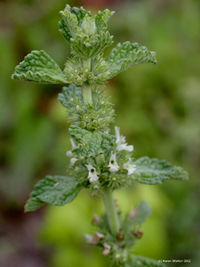Marrubium vulgare
| See Also | Botanical Monographs |
|---|
White Horehound (Marrubium vulgare) is best known as a respiratory tonic. It is used to treat many respiratory conditions, especially those associated with phlegm, such as coughs, laryngitis, chronic bronchitis and pneumonia. To explore the characteristics, medicinal uses and prescribing considerations of this herb in more detail, check out the references indicated.[1], [2]
Contents
Characteristics
- Common Names: White horehound, Horehound
- Family: Laminaceae
- Habitat:
- Parts Used: Whole plant
- Constituents: diterpenes, essential oils, vitamin C, resins, wax phytosterols
- Medicinal Actions: stimulant, tonic, expectorant, antiemetic, bitter, diaphoretic, pectoral, antitussive, diuretic and purgative at high doses
Uses
Medicinal Uses:
- chronic larnyx and bronchial mucous membrane irritation; cough and cold with chronic catarrh; generally chilly; asthma with copious amounts of mucous that is hard to expectorate; pulmonary disease with copious phlegm and mucous catarrh; can hear what needs to be expelled but the cough is nonproductive; laryngitis, hoarseness, chronic bronchitis, pneumonia, smoker's cough with catarrh
Prescribing Considerations
The information provided is intended to augment the treatment from a naturopathic doctor or other trained medical professional. Although most herbs are generally safe, it is recommended that you avoid self-prescribing especially when there is an underlying ongoing medical condition, if you are on any prescription medications or if you are pregnant or breastfeeding.
Formulations and Preparation
- Tincture - 1-30 drops three times daily
- Infusion - 60-120mL three to four times daily, or as needed
- Powder - up to 3-4g daily, 1 drachm daily
- Herbal Syrups - use as needed for cough
1 drachm = 60 drops, 1 tsp, or 1/8 of an ounce.
Safety
The safety and prescribing considerations for this herb include:[3], [4]
- Generally regarded as safe.
- Side-effects are that the herb may act as a diuretic at high doses or a purgative at very high doses therefore use with caution.
- Caution in pregnancy because it may stimulate the uterus due to the volatile oils present.
- Drug-Herb Interactions are rare.
References
- ↑ Boon Heather, Smith Michael (2009) 55 Most Common Medicinal Herbs: The Complete Natural Medicine Guide Second Edition Institute of Naturopathic Education and Research, CCNM Toronto.
- ↑ Godfrey Anthony, Saunders Paul, Barlow Kerry, Gowan Matt (2011) Principles and Practices of Naturopathic Botanical Medicine, Advanced Botanical Medicine. V3 CCNM Press, Toronto.
- ↑ Stargrove Mitchell Bebell, Treasure Jonathan, McKee Dwight L (2008) Herb, Nutrient and Drug Interactions: Clinical Implications and Therapeutic Strategies.
- ↑ Brinker Francis (1997) Herbal Contraindications and Drug Interactions: Plus Herbal Adjuncts With Medicines, 4th Edition Eclectic Medical Publications.
